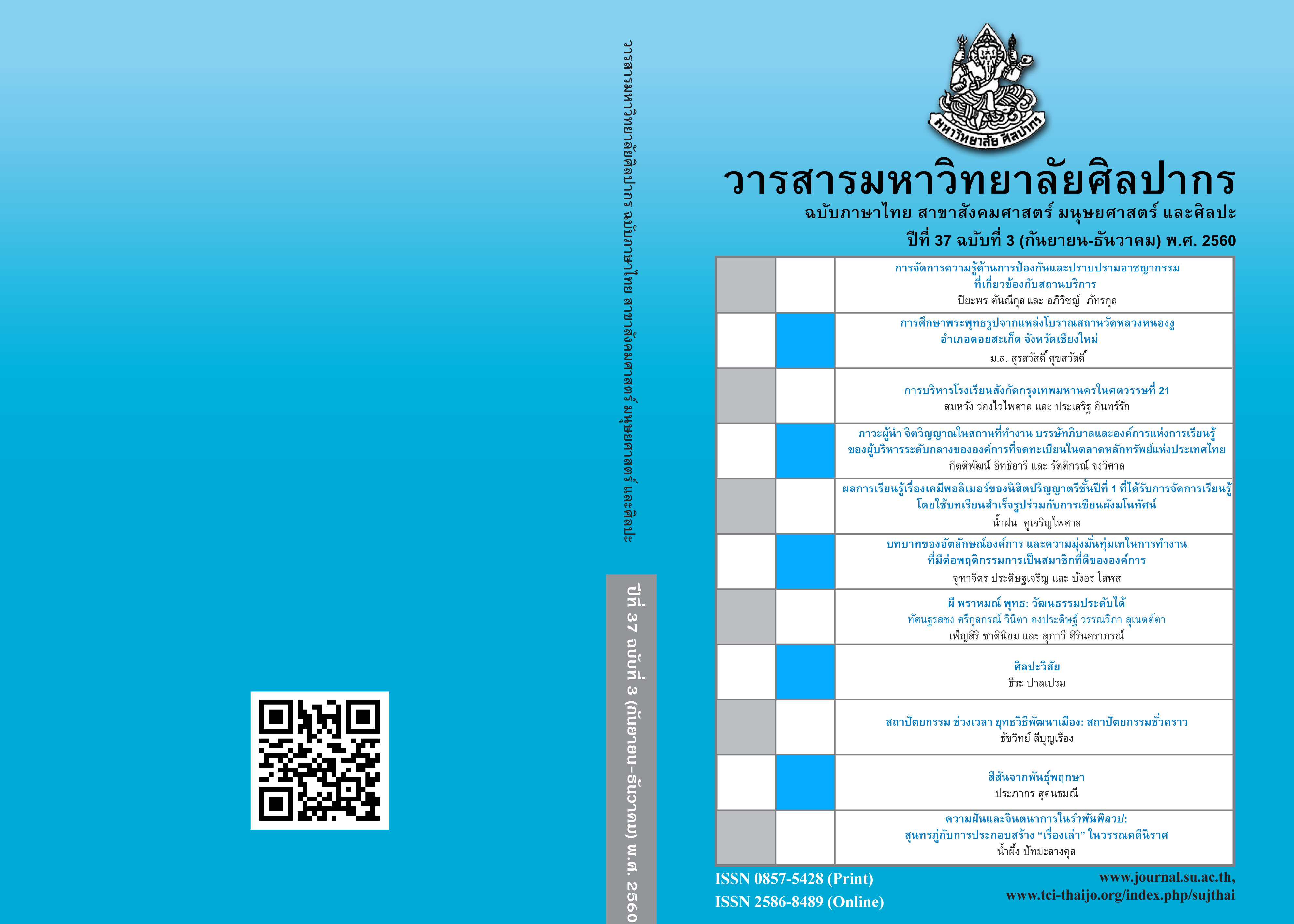การบริหารโรงเรียนสังกัดกรุงเทพมหานครในศตวรรษที่ 21 (School Administration under the Bangkok Metrolitan Administration in 21st Century)
Main Article Content
Abstract
การวิจัยในครั้งนี้ใช้ระเบียบการวิจัยเชิงพรรณนา โดยใช้การวิจัยเชิงคุณภาพและการวิจัยเชิงปริมาณ มีวัตถุประสงค์ (1) เพื่อศึกษาองค์ประกอบของการบริหารโรงเรียนสังกัดกรุงเทพมหานครในศตวรรษที่ 21 และ (2) เพื่อตรวจสอบผลยืนยันองค์ประกอบของการบริหารโรงเรียนสังกัดกรุงเทพมหานครในศตวรรษที่ 21 การวิจัยเชิงคุณภาพผู้วิจัยได้สัมภาษณ์ผู้ทรงคุณวุฒิ 18 ท่าน ส่วนการวิจัยเชิงปริมาณ ใช้ประชากรในการวิจัย คือ สำนักงานเขตของกรุงเทพมหานคร จำนวน 50 เขต การกำหนดขนาดของกลุ่มตัวอย่าง กำหนดขึ้นโดยใช้ตารางของเครจซี่และมอร์แกน (Krejcie & Morgan, 1980: 605) ได้จำนวน 48 เขต โดยมีกลุ่มตัวอย่าง แบ่งออกเป็น 3 กลุ่ม คือ กลุ่มที่ 1 ฝ่ายบริหาร ได้แก่ ผู้อำนวยการเขต ผู้บริหารสถานศึกษา กลุ่มที่ 2 ฝ่ายปฏิบัติการ ได้แก่ ศึกษานิเทศก์เขต ครูที่ทำหน้าที่วิชาการ กลุ่มที่ 3 ฝ่ายสนับสนุน ได้แก่ ประธานคณะกรรมการสถานศึกษาขั้นพื้นฐาน หัวหน้าฝ่ายการศึกษาในสำนักงานเขต รวมผู้ให้ข้อมูลจากสำนักงานเขตๆ ละ จำนวน 6 คน รวมผู้ให้ข้อมูลหลักทั้งสิ้นจำนวน 288 คน เครื่องมือที่ใช้ในการวิจัย ได้แก่ แบบสัมภาษณ์และแบบสอบถามเกี่ยวกับการบริหารโรงเรียนสังกัดกรุงเทพมหานครในศตวรรษที่ 21 สถิติที่ใช้ในการวิจัย ประกอบด้วย ความถี่ ร้อยละ ค่ามัชฌิมเลขคณิต ส่วนเบี่ยงเบนมาตรฐาน และการวิเคราะห์องค์ประกอบ
ผลการวิจัย พบว่า 1.องค์ประกอบของการบริหารโรงเรียนสังกัดกรุงเทพมหานครในศตวรรษที่ 21ประกอบด้วย 3 องค์ประกอบหลัก 4 องค์ประกอบย่อย คือ 1) โรงเรียนแห่งการเรียนรู้ในศตวรรษที่ 21 ประกอบด้วย 1.1) การบริหารจัดการโรงเรียนในศตวรรษที่ 21 และ 1.2) การจัดกิจกรรมเสริมทักษะที่จำเป็นสำหรับนักเรียนในศตวรรษ ที่ 21 , 2) สมรรถนะสำหรับผู้บริหารในศตวรรษที่ 21 ประกอบด้วย 2.1) คุณสมบัติสำหรับผู้บริหารในศตวรรษที่ 21 และ 2.2) ทักษะการบริหารของผู้บริหารในศตวรรษที่ 21 และ 3) การควบคุมการจัดการศึกษาในศตวรรษที่ 21 2. องค์ประกอบของการบริหารโรงเรียนในศตวรรษที่ 21 เป็นพหุองค์ประกอบ และมีความเหมาะสม มีความเป็นไปได้ มีประโยชน์และถูกต้องครอบคลุมสอดคล้องกับทฤษฎี หลักการและแนวคิดตามกรอบการวิจัย
This research is a descriptive research using qualitative and quantitative methods. The purposes of study were: [1] To investigate the elements of school administration under the Bangkok Metropolitan Administration in the 21st century, and [2] To check the elements of school administration under the Bangkok Metropolitan Administration in the 21st century. Based on the qualitative method, 18 experts were interviewed. The population of this study was 50 district offices in Bangkok Metropolitan. The samples were 48 district offices determined by Krejcie and Morgan table (1970: 605). The respondents were divided into three groups: 1] Administration group comprising district directors and school administrators, 2] Operation group comprising supervisors and academic teachers, and 3] support group comprising the chairmen of the school board and the heads of district education in Educational Service Area Office. The subjects were 288 from 6 each Educational Service Area Office in 48 Area Offices. The research instruments were interview form and questionnaire. The statistics for analysis were frequency, percentage, arithmetic mean, standard deviation and exploratory factor analysis.
The findings were as follows: 1. There were three main elements and four sub-elements of the school administration under the Department of Education Bangkok Metropolitan in the 21st century, namely, 1] Learning organization of school in 21st century, including 1.1] School administration in 21st century and 1.2] Skill for students; 2] Competencies of administrators, including 2.1] Qualification of Administrators, 2.2] Skills of administrators; and 3] Educational control. 2. The elements of school administration under the Department of Education Bangkok Metropolitan in the 21st century were multiple component and appropriate, possible, advantageous and accurate based on the theories, principles and concepts of the research framework.
Downloads
Article Details
References
Chaiyajitkamtorn, M., (2012). SWOT Analysis (การวิเคระห์สภาพแวดล้อมองค์กร) Pimlak. Bangkok: Pinkoaw Printing
Offiice.
Conbach, L. J. (1970). Essentials of Psychological Test (5th ed.). New York: Harper Collins.
Prahalad, C. K. (1986). Management 21C: Someday Well All Mange this way.London : Financial Time Prentice Hall. pp. 485-501.
Data center of Bangkok, (2015).Model Management of Bangkok. Retrieved on March 30, 2015, from http://203.155.220.230/m.info/bma_k/knw5.html
Conklin, D., & Lawrence T. (2003). Management : 21C. Retrieved on April 22, 2015,from E-mail: maruays@Yahoo.com
Deming, W. E. (1995). Out of The Crisis. USA: The Massachusetts Institute ofTechnology Center for Advanced Engineering Study.
Dructer P. F. (2015). Management Challenges , Retrieved on Octerber 20, 2015,from http://www.novabizz.com/NovaAce/Mange/Management_Challenges.htm#ixzz2zVSbnbz
Edwards,TB. (1950). Measurement of some aspects of critical thinking. Journal of Experimental Education, 18, 263–278.
Hamel, G. (2007). The Future of Management. Boston: Havard Business School Press.
Halpern, D. F., (1998). Teaching critical thinking for transfer across domains:Disposition, skills, structure training, and metacognitive monitoring.American Psychologist, 53(4), 449–455.
Bouchikhi, H., & Kimberly, J. R. (2003). Management: 21C. Retrieved on April 22, 2015, from E-mail: maruays@Yahoo.com
Holmberg, I., & Ridderstrale, J. (2003). Management 21C : Someday Well All Mange this way. London: Financial Time Prentice Hall
Foppen, J.W. (2003). Management: 21C. Retrieved on April 22, 2015, fromE-mail: maruays@Yahoo.com
Kouzes, J. M., & Posner B. S. (2003). Management: 21C. Retrieved April 22, 2015, from E-mail: maruays@Yahoo.com
Kapajan, P. & Kongtaing, S., (2002). Principle and Philosophy of Educational (หลักและปรัชญาการบริหารการศึกษา) Bangkok: RamkhamheangUniversity Printing.
Lorange, P. (2003). Management: 21C. Retrieved on April 22, 2015, from E-mail:maruays@Yahoo.com
Munkong, S. (2015). Quality Control Circle. Retrieved on May 30, 2015, fromhttp://qualitycontrolcircles.blogspot.com/2011/03/qcc.html
Rerntong, N. (2007). Pattern of School Administration to be effectiveness. Dissertation in Educational Administration Program at Graduate School, SilpakornUniversity, Nakorn Pathom, Thailand.
Chowdhury, S. (2003). ed., Management 21C : Someday Well All Mange this way. London: Financial Time Prentice Hall.
Sairam, B. (2015). Administration and Education Improvement (การบริหารและพัฒนาการศึกษา). Mahasarakam University, Retrieved on January 20, 2015, from http://www.gotoknow.org/posts/565807
Schermerhorn, J. R., Hunt, J. G., Osborn R. N. (2000). Organizational Behavior. New York : John Wiley&Sons Inc.
Ghoshal, S., Bartlett, C. A., & Moran, P. (1987). Management 21C: Someday Well All Mange this way. London: Financial Time Prentice Hall. pp. 43 – 53
Sonatanan, M.(2003).Management: 21C. Retrieved on April 22, 2015, fromE-mail : maruays@Yahoo.com
Wachayanon, N. (2008). Competency – Based Approach. Bangkok: Graffico System.
Yawirat, N. (2010). Modern Management (การจัดการสมัยใหม่). Bangkok: Soi Book center of Juralongkorn University.


